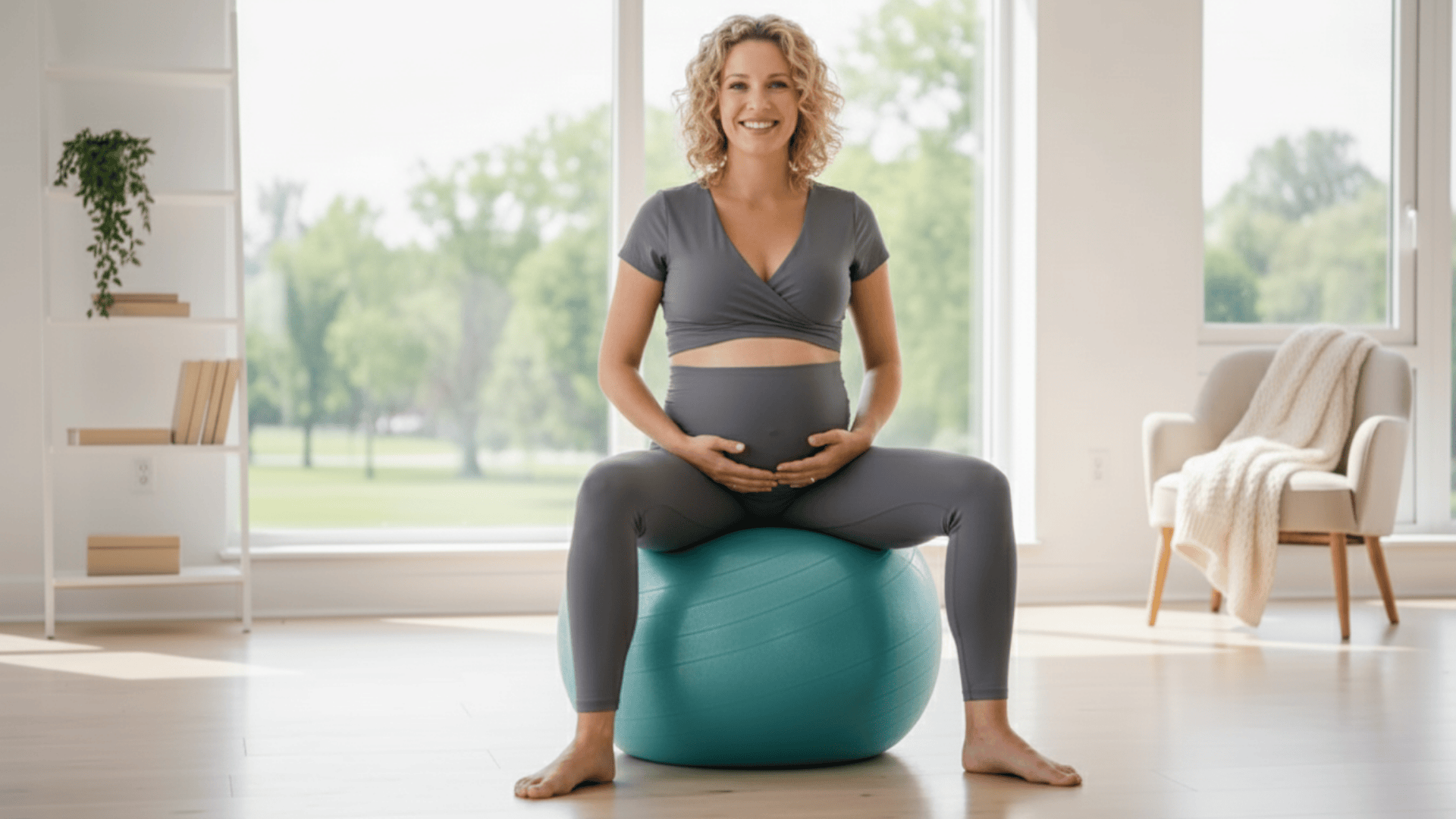Hey mama! If you’re feeling those familiar pregnancy aches or just want to stay active safely, I’ve got something to share with you.
A pregnancy ball might just become your new best friend during these nine months.
This isn’t just about exercise; it’s about finding comfort when your back is killing you, preparing your body for labor, and carving out those precious moments of calm you desperately need.
I’ve put together these gentle, safe moves that work if you’re just starting to show or counting down the days.
Ready to feel better in your beautiful, changing body?
What is a Pregnancy Ball?
A pregnancy ball might look similar to the exercise ball you’d see at the gym, but it’s specifically designed with expectant mothers in mind.
These balls are typically made with anti-burst technology, and they come in different sizes to match your height.
Getting the right size matters: If you’re under 5’4″, go for a 55cm ball. Between 5’4″ and 5’10”? A 65cm ball is perfect. Taller than 5’10”? You’ll want a 75cm ball.
When you sit on it, your hips should be slightly higher than your knees. This helps maintain good posture and makes the exercises more effective.
Safety First: Always use your ball on a non-slip surface, and keep good posture with your feet flat on the floor and shoulders relaxed. If you’re new to using one, practice near a wall or sturdy furniture until you feel confident.
Important Safety Notes Before You Start
Before starting any new exercise routine during pregnancy, consult your doctor or midwife first. They know your specific situation best and can give you the green light to start.
Keep these safety tips in mind:
- Avoid any high-intensity bouncing or movements that feel like overstretching.
- Stay hydrated and listen to what your body is telling you.
- Wear grip socks or exercise near something stable you can hold onto.
- If something doesn’t feel right, stop and rest.
Remember, this isn’t about pushing yourself to the limit; it’s about gentle, supportive movement that feels good.
Pregnancy Ball Exercises and Yoga Moves
Let’s try these exercises, grouped by the area they primarily assist with. Mix and match based on what your body needs each day!
1. Gentle Hip Circles
Sit comfortably on your ball with feet flat on the floor. Slowly rotate your hips in small circles, first one direction, then the other. This helps loosen tight pelvic joints and feels great after sitting at a desk all day.
Do this for 30 seconds in each direction. Over time, it can also improve flexibility in your lower back and hips. Try pairing it with deep breathing to release even more tension.
2. Side-to-Side Rocking
From your seated position, gently shift your weight from your left hip to your right hip, creating a smooth rocking motion. This is perfect for easing lower back tension and can be incredibly soothing.
Rock back and forth for about a minute. It also promotes better circulation in your lower body, especially after long periods of sitting. The gentle sway has a calming effect that can double as a mini stress reliever.
3. Pelvic Tilts (Cat-Cow Variation)
While seated on the ball, place your hands on your hips. Gently tilt your pelvis forward, then tilt it backward. This movement helps align your spine and gently engages your core.
Repeat 8–10 times slowly. It’s also a great way to improve posture awareness throughout the day. Over time, this exercise can strengthen your core muscles and support a healthier spine.
4. Seated Bouncing
Sit on the ball and gently bounce up and down, keeping your feet firmly planted. This isn’t about big bounces; think gentle pulses that engage your core and encourage baby’s descent.
Start with 30 seconds and gradually build up. It’s also a fun way to release tension and stay lightly active.
5. Wall Ball Squats
Place the ball between your lower back and the wall. Slowly squat down, using the ball for support.
This strengthens your legs and glutes while being much easier on your joints than regular squats. Start with 5–8 squats. Over time, it helps build stamina for labor and daily movement.
6. Ball-Assisted Supported Bridge
Lie on your back (only if you’re still comfortable in this position) with your calves resting on the ball. Gently lift your hips up, creating a small bridge shape.
This strengthens your glutes and core while being gentle on your back. Hold for a few seconds, and repeat 5–8 times. It’s a safe, low-impact way to support pelvic stability.
7. Child’s Pose with Ball Stretch
Kneel on the floor with the ball in front of you. Lean forward and drape your arms over the ball, resting your forehead on it if comfortable. This releases tension in your back and shoulders beautifully.
Hold for 30 seconds to a minute. The ball provides extra support, making it gentler on the belly during pregnancy. It’s also a calming posture that promotes relaxation and steady breathing.
8. Yoga Seated Forward Fold (Ball Support)
Sit on the floor with legs extended (or slightly bent if more comfortable) and place the ball in front of you. Gently lean forward, resting your arms and chest on the ball. This stretches your spine and hips while providing support.
Hold for 30–45 seconds. The ball prevents overstretching, keeping the pose safe and restorative. It’s a great way to open tight hamstrings while reducing stress.
9. Kegel Engaged Breathing on Ball
Sit upright on the ball with good posture. As you breathe in deeply, relax your pelvic floor muscles. As you exhale, gently engage them (like you’re lifting them up and in).
This combines pelvic floor strengthening with calming breathwork. Repeat 8–10 times. Over time, it can improve pelvic strength and bladder control. The mindful breathing also helps prepare you mentally for labor.
10. Labor Prep Rocking Hug
Lean forward and wrap your arms around the ball in a gentle hug. Rock side to side slowly, breathing deeply. This position is wonderful for labor preparation and can help encourage optimal fetal positioning.
Rock for 2–3 minutes or as long as it feels good. It also relieves lower back pressure and provides emotional comfort. Many women find it a grounding and soothing posture during pregnancy.
11. Prenatal Yoga Meditation (Seated on Ball)
Simply sit on the ball with your spine tall and hands resting on your belly or in your lap. Close your eyes and focus on your breathing. The gentle instability of the ball keeps you engaged while allowing deep relaxation.
Practice for 5–10 minutes. It’s perfect for connecting with your baby and cultivating mindfulness. This simple practice can reduce stress and promote a sense of calm throughout pregnancy.
Creating Your Daily Pregnancy Ball Exercise Routine
Mix and match 3-4 pregnancy ball exercises each day to keep things interesting and address your body’s changing needs.
Start your morning energized with bouncing exercises and hip circles on your pregnancy ball, or create a calming evening routine with gentle stretches and supported positions.
Morning Pregnancy Ball Exercises:
- Gentle bouncing to wake up your core
- Hip circles while seated on the ball
- Pelvic tilts for lower back relief
- Supported squats using the ball against the wall
Evening Wind-Down Pregnancy Ball Exercises:
- Forward fold with ball support
- Gentle back stretches, leaning over the ball
- Meditation pose while seated on the ball
- Side-lying positions with the ball for support
Listen to your body’s daily signals; some days you might feel energized for more active pregnancy ball exercises that build strength, while other days call for gentle stretching and relaxation movements with your ball.
Wrapping It Up
Mama, you’ve got this! These pregnancy ball exercises aren’t just movements; they’re your daily dose of self-care during this incredible path.
If you’re seeking relief from back pain, preparing for labor, or simply wanting gentle moments of peace, your pregnancy ball is there for you every step of the way.
Be patient with yourself, listen to your body, and celebrate every small step toward feeling stronger and more comfortable.
Ready to change how you feel during pregnancy?





